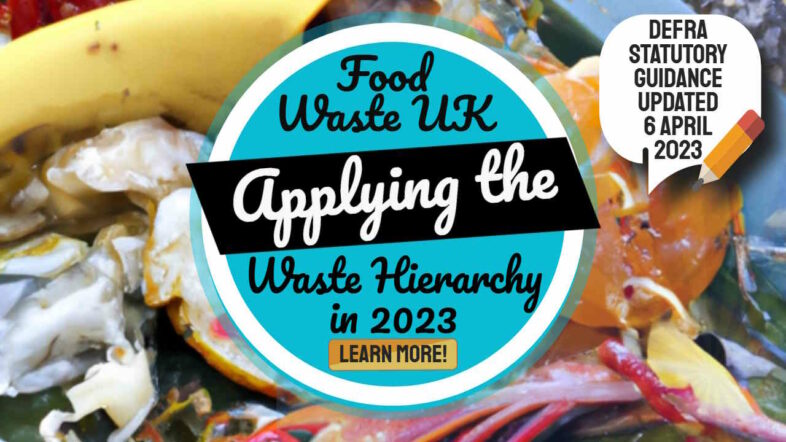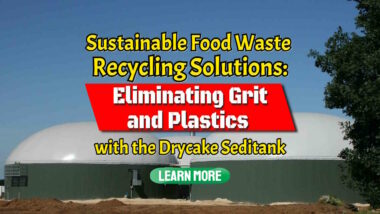It is important to understand important details in the way UK waste managers should apply the general rules of the waste hierarchy to the special case of food waste.
The waste hierarchy is a tool that is used to guide sustainable waste management practices. It prioritizes waste reduction and prevention at the top, followed by reuse, recycling, recovery, and disposal as a last resort.
The UK DEFRA Guidance is available on the government website: Statutory Guidance Food and drink waste hierarchy: deal with surplus and waste, Updated 6 April 2023.
To quote their introductory paragraph:
“Your priority should be to prevent producing food and drink waste in the first place.
Following this hierarchy will help you to:
- minimise the environmental impact of food and drink waste
- maximise the value of food and drink surplus, for example by reselling or donating to charity
- reduce associated waste, for example, packaging
The government’s policy on preventing and managing food and drink waste is set out in the
When it comes to food waste, applying the UK waste hierarchy can help reduce the negative environmental impact of food waste generation.
Disclaimer: This document is for those that like to read about this subject and is for entertainment only. In no way is this document to be interpreted to conflict in any way with the UK Statutory Guidance – Food and drink waste hierarchy or any other guidance.
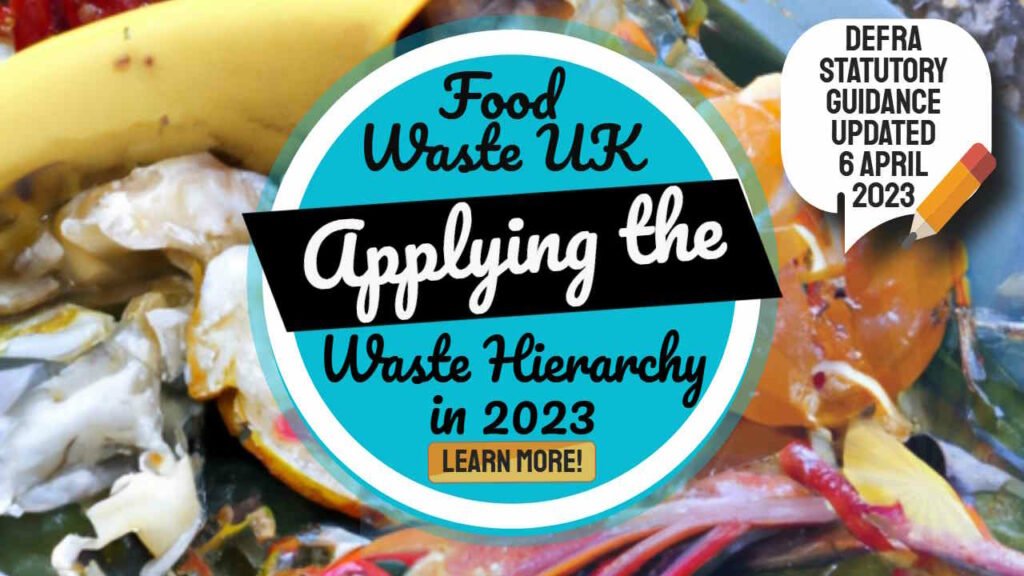
Food Waste UK – The Official Priority List
In the case of food the UK Guidance states:
- Prevent surplus and waste in your business.
- Redistribute surplus food and drink.
- Make animal feed from former food.
- Process surplus food to make biomaterials.
- Recycle – anaerobic digestion and composting.
- Recover waste by landspreading.
- Recover energy from waste.
- Dispose – send to sewer and landfill.
Your decisions about food surplus and waste may depend on the cost and facilities available. You should apply the actions in the order they are listed, where possible.
Implementation of the Official UK Waste Hierarchy – Quick Take-Aways
The following is fairly obvious to anyone with a general knowledge of the waste hierarchy. Let’s call them the quick “takeaways” for good Food Waste UK management!
Reduce
At the top of the waste hierarchy, reducing the amount of food waste generated should be the primary focus. This can be done by implementing practices such as better food storage, menu planning, and portion control.
This approach not only reduces the amount of waste generated but can also lead to cost savings for food businesses.
Reuse
Next in the waste hierarchy is reuse. This can involve finding alternative uses for food waste, such as using it as animal feed or composting it for use in gardens.
Recycle
Recycling food waste through anaerobic digestion to produce biogas or composting it to create nutrient-rich soil amendments is another example of reuse. When it comes to environmental impact, anaerobic digestion triumphs over composting. In addition to recycling nutrients in the digestate, it can also generate renewable energy.
Recover

Recovery is the third step in the waste hierarchy and involves extracting value from food waste.
For example, food manufacturers can recover food by-products such as oils or sugars to create new food products or as feedstock for other industries.
Recover Energy
Additionally, food waste can be used as biofuel when converted into ethanol or other fuels. Disposal is the final step in the waste hierarchy and should be seen as a last resort.
Disposal
Landfilling food waste contributes to greenhouse gas emissions which are harmful to the environment. Waste incineration also has negative impacts on air quality and can lead to toxic emissions.
In conclusion, applying the general waste hierarchy to food waste can improve sustainability outcomes for businesses, the environment, and society. By prioritizing waste reduction and focusing on the recovery and reuse of food waste, businesses can reduce their environmental impact while also reducing their operational costs.
A Deeper Look at Food Waste UK Guidance
For food waste experts, and businesses there are 8 steps in the hierarchy you that need to be followed according to the UK statutory guidance on good practice. So now we will take each step in the hierarchy from the Food Waste UK guidance and look at each in turn:
1 – Prevent surplus and waste in your business
Preventing surplus and waste in your business is an essential strategy for improving profitability, reducing costs, and enhancing sustainability. By taking proactive measures to prevent waste and surplus, your business can streamline operations, optimize resources, and minimize negative impacts on the environment.
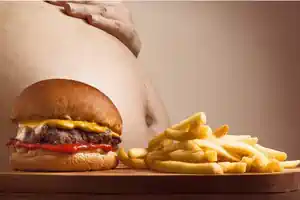 One effective approach to reducing surplus and waste is to conduct regular audits of your inventory and supply chain processes. By analyzing your purchasing habits, you can identify areas where you may be over-ordering or overproducing, and adjust your operations accordingly.
One effective approach to reducing surplus and waste is to conduct regular audits of your inventory and supply chain processes. By analyzing your purchasing habits, you can identify areas where you may be over-ordering or overproducing, and adjust your operations accordingly.
Additionally, implementing lean manufacturing and just-in-time inventory management strategies can help you minimize waste in your production processes. These approaches can help you reduce inventory carrying costs, reduce the need for expensive storage space, and minimize the environmental impact of your business activities.
Another important aspect of preventing surplus and waste is to promote a culture of sustainability within your organization. By educating your employees about the importance of waste reduction and encouraging them to adopt environmentally friendly practices, you can build a culture of sustainability that will help your business achieve long-term success.
By taking a proactive approach to reducing surplus and waste, your business can improve its bottom line, enhance its reputation, and contribute to a healthier planet for future generations.
2 – Redistribute surplus food and drink
Redistributing surplus food and drink can be a great way to tackle food waste and help those in need. Each year, millions of tons of perfectly edible food are thrown away by businesses and households across the world, while many people struggle to access nutritious food. The redistribution of surplus food and drink can help to bridge this gap and benefit communities on multiple levels.
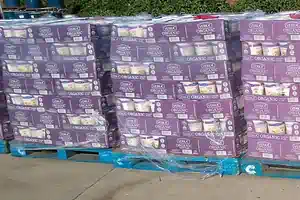 By redirecting excess food to those in need, individuals and organizations can help to reduce food waste, lessen the environmental impact of food production, and provide essential resources to those who might otherwise go hungry. This not only benefits the recipients but also creates a more sustainable and equitable food system.
By redirecting excess food to those in need, individuals and organizations can help to reduce food waste, lessen the environmental impact of food production, and provide essential resources to those who might otherwise go hungry. This not only benefits the recipients but also creates a more sustainable and equitable food system.
Many organizations specialize in collecting and redistributing surplus food and drink, working with businesses, food banks, and community organizations to ensure that food reaches those who need it most. This approach also supports local economies, as surplus food and drink are redirected to local communities, rather than ending up in a landfill.
Overall, the redistribution of surplus food and drink presents a win-win solution for both businesses and communities, providing a simple yet effective way to address food waste while helping vulnerable populations to access essential resources.
3 – Make animal feed from former food
Animal feed is an essential component of livestock farming, and its quality and composition are critical in ensuring the health and productivity of animals. However, conventional animal feed production methods can be costly, resource-intensive, and environmentally harmful.
In recent years, there has been growing interest in using former food as a viable alternative to traditional feed sources.
 This innovative approach involves repurposing food that would have otherwise gone to waste, such as expired or unsold grocery items, into nutrient-rich animal feed. The process not only reduces waste and landfill usage but also offers a sustainable solution to the rising demand for animal feed.
This innovative approach involves repurposing food that would have otherwise gone to waste, such as expired or unsold grocery items, into nutrient-rich animal feed. The process not only reduces waste and landfill usage but also offers a sustainable solution to the rising demand for animal feed.
Additionally, the former food-based feed can be customized to provide the required nutritional profile for different animal species, thereby optimizing animal health and production.
The benefits of using former food as animal feed extends beyond sustainability, with potential cost savings for farmers and improved animal welfare. As such, the use of former food as animal feed presents a promising opportunity for the agricultural industry to transition towards more sustainable and responsible practices.
The Danger of Plastic Particles in Animal Feed
It has come to our attention that animal feed in the UK is being used which contains shredded biscuits, bread and other food waste which has been shredded without any pretreatment to remove packaging. The UK regulations on animal feed production do not appear to limit the presence of plastic including microplastic in animal feed.
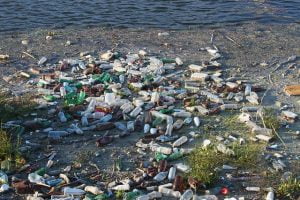 This practice should be avoided because it is now known that microplastic has a damaging effect on the environment and can affect the viability of global ecosystems. Recently developed depackaging systems are available which avoid the creation of microplastics such as the Drycake Twister range of Depackagers and Separators.
This practice should be avoided because it is now known that microplastic has a damaging effect on the environment and can affect the viability of global ecosystems. Recently developed depackaging systems are available which avoid the creation of microplastics such as the Drycake Twister range of Depackagers and Separators.
These low-impact depackagers have the added advantage that the reject stream complies with the requirements of RDF production for a high calorific value. This can mean that rather than the rejects being costly waste requiring landfill disposal, they can be recycled via standard MRF and ERF recycling facilities.
4 – Process surplus food to make biomaterials
The process of producing biomaterials from surplus food involves converting food waste into new and useful materials that can be used in various industries. This sustainable approach to waste management has numerous benefits, including reducing the amount of waste sent to landfills, conserving natural resources, and reducing greenhouse gas emissions.
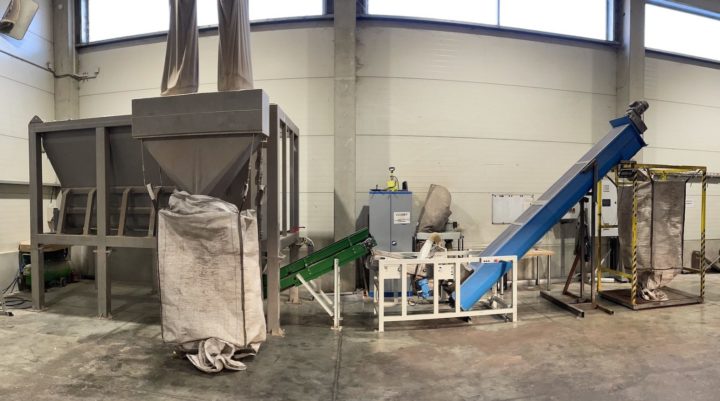
Biomaterials can be created using different techniques, such as fermentation, enzymatic hydrolysis, and extraction. The resulting materials can include biofuels, bioplastics, and bio-based chemicals. One of the most significant advantages of producing biomaterials from surplus food is the potential to create a circular economy.
By diverting food waste from landfills and using it to produce new materials, we can reduce our reliance on virgin resources and reduce the negative environmental impacts associated with traditional manufacturing. Furthermore, the production of biomaterials supports local economies by creating jobs and new revenue streams.
Overall, the process of producing biomaterials from surplus food presents a significant opportunity to reduce waste, conserve resources, and create a more sustainable future.
As more industries look for ways to reduce their environmental footprint, the use of biomaterials is likely to become more prevalent. With continued research and investment, we can develop new and innovative ways to transform food waste into valuable resources.
5 – Recycle – anaerobic digestion and composting
Recycling has become an increasingly important issue in modern society due to the rise of environmental concerns. As a result, many countries have implemented various recycling methods to encourage sustainable waste management. Two of the most common methods are anaerobic digestion and composting, with anaerobic digestion being the preferred process above composting within the hierarchy.
Anaerobic digestion involves the use of microorganisms to break down organic material in an oxygen-free environment. This process produces biogas, a renewable energy source, and a nutrient-rich digestate that can be used as fertilizer. Anaerobic digestion is commonly used to treat food waste, agricultural waste, and sewage sludge.
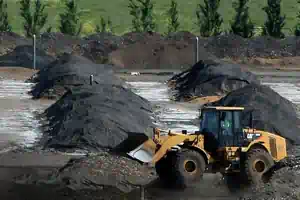 Composting, on the other hand, is a process that also involves the natural decomposition of organic waste. But the difference with this method is that it requires oxygen, which is supplied by regularly turning the compost pile. The end product is a nutrient-rich soil amendment that can be used to enrich garden soil, agricultural land, and landscaping projects.
Composting, on the other hand, is a process that also involves the natural decomposition of organic waste. But the difference with this method is that it requires oxygen, which is supplied by regularly turning the compost pile. The end product is a nutrient-rich soil amendment that can be used to enrich garden soil, agricultural land, and landscaping projects.
Both anaerobic digestion and composting are effective ways to reduce the amount of organic waste that ends up in landfills, which contributes to greenhouse gas emissions.
Recycling these materials through anaerobic digestion and composting not only benefits the environment but also promotes a sustainable economy, as it creates jobs and produces renewable energy and agricultural products. Therefore, it is essential for communities and individuals to prioritize recycling and implement these methods to promote a cleaner, healthier, and more sustainable future.
The Danger of Plastic Particles in Digester Pulp Feedstock
Food waste from all sources is invariably contaminated to a degree with plastic.
In the UK guidance (Section 5.3) the government defines depackaging as the recovery of waste food by decanting or unwrapping it and recycling the packaging where possible. This indicates that depackaging is a manual process, whereas the truth is that few businesses can afford to employ staff for this duty. Most UK food waste depackaging is done mechanically by machines and has been for at least the last 30 years.
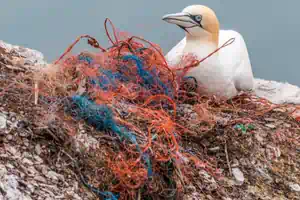 In the past, virtually all organic waste depackaging and separation equipment available worked on the principle of particle size reduction. Only recently, since 2018 and Richard Attenburgh’s moving TV series which shows the severe effects of ocean-borne plastic on marine life has this been seen as a major environmental issue. Plastic that enters a digester also leaves it in the digestate. Digestate is spread on land as a fertiliser. The UK regulations (not SEPA) on the landspreading of plastic particles such as in PAS100 and PAS 110 are inadequate to protect the environment as they are weight-based and allow excessive plastic presence.
In the past, virtually all organic waste depackaging and separation equipment available worked on the principle of particle size reduction. Only recently, since 2018 and Richard Attenburgh’s moving TV series which shows the severe effects of ocean-borne plastic on marine life has this been seen as a major environmental issue. Plastic that enters a digester also leaves it in the digestate. Digestate is spread on land as a fertiliser. The UK regulations (not SEPA) on the landspreading of plastic particles such as in PAS100 and PAS 110 are inadequate to protect the environment as they are weight-based and allow excessive plastic presence.
Recently developed depackaging systems are available which avoid the creation of microplastics such as the Drycake Twister range of Depackagers and Separators.
6 – Recover waste by landspreading
Landspreading is a crucial technique used to recover organic waste that has been generated in various industries. The technique involves the application of some forms of food waste, manure, and wastewater sludge on agricultural lands to improve soil health and crop yields. The process is justifiable at this level in the hierarchy for the disposal of organic waste as it enables the nutrients from the waste to be recycled back into the soil.
By landspreading, we can recover waste sustainably, while also improving soil quality and reducing the risk of groundwater pollution. This technique not only benefits the environment but also provides financial benefits to the industries involved in waste generation.
Landspreading can be an affordable alternative to other waste management methods such as landfilling or incineration. It also presents an opportunity to reduce carbon emissions by making use of organic waste to produce energy or as a source of carbon sequestration.
However, it is important to ensure that the waste being used is free from harmful contaminants, complies with UK nutrient loading criteria, and is safe for land application. For this to work without causing river pollution, it is essential to have a well-regulated system that monitors the quality of the waste being land spread and ensures the technique is being used appropriately.
In conclusion, landspreading is a sustainable and cost-effective approach to recovering waste. It has the potential to contribute to a circular economy by recycling waste and reducing the environmental impact of waste disposal.
The proper implementation of this technique, coupled with effective regulation, will ensure that the benefits of landspreading are maximized while protecting the environment and human health.
The Danger of Plastic Particles in Food Waste Used for Land Spreading
As highlighted earlier in this article, food waste from all sources is invariably contaminated to a degree with plastic. In the past, virtually all organic waste depackaging and separation equipment available worked on the principle of particle size reduction. This is a major environmental issue. The UK regulations (not SEPA) on the landspreading of plastic particles such as in PAS100 and PAS 110 are inadequate to protect the environment as they are weight-based and allow excessive plastic presence.
Recently developed depackaging systems are available which avoid the creation of microplastics such as the Drycake Twister range of Depackagers and Separators.
7 – Recover energy from waste
The concept of recovering energy from waste is gaining in popularity in today’s day and age as it is a relatively sustainable solution albeit it is second from the bottom of all options in the waste hierarchy. Its use is still able to reduce the environmental impact of waste disposal.
It involves the process of converting municipal solid waste, agricultural waste, and industrial waste into energy sources like electricity, heat, and fuel. This process is known as waste-to-energy (WtE) and is considered an effective way to minimise the volume of waste sent to landfill or incineration.
Recovering energy from waste can also help in reducing greenhouse gas emissions, and air and water pollution, and promote a circular economy. Many local and regional authorities have implemented WtE plants, and they have proved to be successful in generating clean energy.
The process of WtE involves several steps such as sorting, shredding, combustion, and energy conversion. This process not only helps in generating energy but also reduces the volume of waste to be disposed of, thereby saving precious landfill space.
Moreover, it provides job opportunities and can contribute to the economic growth of a region.
In conclusion, the concept of recovering energy from waste is a sustainable solution that not only helps in reducing the environmental impact of waste disposal but also generates clean energy sources.
The process of waste-to-energy is an effective way to promote a circular economy and reduce greenhouse gas emissions. Implementing WtE plants can not only create job opportunities but also contribute to the economic growth of a region. It is an innovative and efficient solution that can be vital in achieving a sustainable future.
8 – Dispose of – send to sewer and landfill.
As a society, we generate a significant amount of waste every day, ranging from household garbage to industrial waste. The responsible management and disposal of this waste are crucial for protecting the environment and reducing the negative impact of pollution.
One of the common methods for disposing of the waste is by sending it to sewers and landfills. Sewers are designed to collect and transport wastewater and other types of liquid waste to treatment plants, where it is processed and cleaned.
Landfills, on the other hand, are designated areas where solid waste is buried in the ground. Both these methods of disposal require careful planning and regulation to ensure that the waste does not pose a risk to human health or the environment.
A Conclusion for Food Waste UK Guidance
Good waste management practices for food waste just as in all wastes include, above all reducing the overall amount of waste produced, but when still produced, source-separating recyclable and non-recyclable materials, and using advanced technologies to improve the sustainability of their management.
This requires a collaborative effort from individuals, businesses, and governments to create more circular sustainable waste management systems that preserve natural resources and protect public health. Ultimately, conscientious waste disposal practices will pave the way towards a cleaner and safer environment for all.


